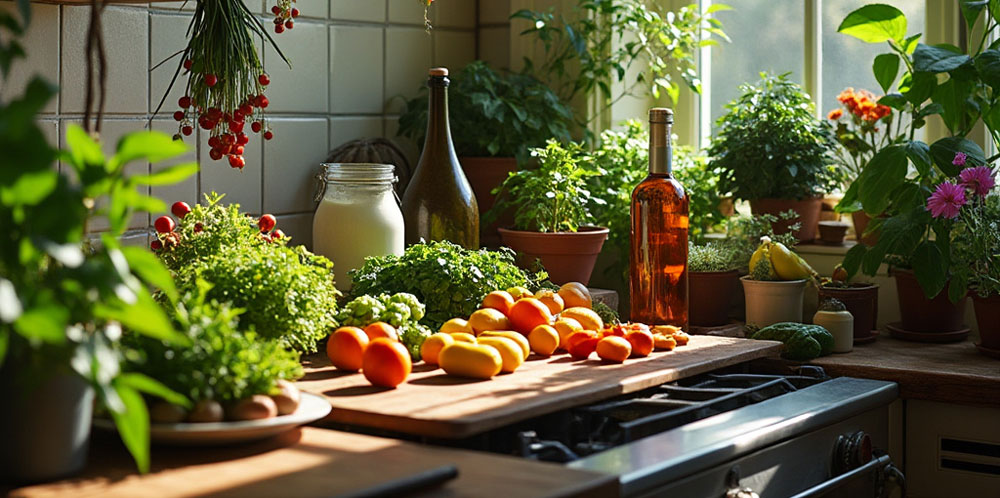
In every home, where the kitchen meets the garden, a space exists where the magic of flavor begins. For the gardener who grows not just for beauty or quantity but for the depth of taste and culinary utility, the garden becomes an extension of the kitchen—a living pantry where each plant is chosen for its contribution to the palate.
The Philosophy of Flavor-Focused Gardening
Gardening for flavor is an art that goes beyond mere cultivation. It's about understanding that the taste of a plant is influenced by its environment, care, and even the time of day it's harvested. This approach not only enhances your meals but also deepens your connection with the food you eat.
Environmental Factors Affecting Flavor
The environment in which your plants grow plays a crucial role in developing their flavors:
- Soil Health: Rich, well-drained soil teeming with organic matter is the foundation of flavorful produce. Enhance your soil with compost, worm castings, and natural fertilizers.
- Watering: Consistent moisture levels help plants develop robust flavors. Overwatering can dilute flavors, while underwatering can concentrate them undesirably. Improve drainage in wet seasons to prevent flavor dilution.
- Sunlight and Climate: Most flavor-intensive plants require full sun. The energy from sunlight directly impacts the production of essential oils and compounds that give herbs and vegetables their taste. Consider your local climate and create microclimates in your garden to support a variety of plants.
Choosing and Growing Flavorful Plants
When planning your tasteful garden, consider what you love to cook with:
Herbs
Basil, rosemary, thyme, and mint are kitchen staples. Each brings unique flavors that can transform your dishes. Basil, for example, thrives in warm conditions and can be used fresh or turned into pesto.
Vegetables
Tomatoes, peppers, and eggplants are ideal for those who love Mediterranean or Mexican cuisine. Heirloom varieties often offer superior flavor over commercial hybrids.
Greens and Edible Flowers
Arugula, spinach, and kale provide both nutrition and a spectrum of flavors from peppery to sweet. Edible flowers like nasturtiums, pansies, and violets can add both color and subtle taste to salads or as garnishes.
Alliums
Garlic, onions, and chives are flavor powerhouses. Their pungent flavors can be moderated by cooking methods or used raw for a sharp bite.
Companion Planting and Rotation
Interplant compatible species to enhance flavors and deter pests. For instance, planting basil near tomatoes is believed to improve the taste of both. For a detailed breakdown on all veggies and their best companions for flavor, read this article. Rotate crops seasonally to prevent soil depletion and maximize variety in small spaces.
Harvesting and Storage for Maximum Flavor
The way you harvest and store your produce can significantly impact its flavor:
- Timing: Harvest at the right time to maximize flavor. Herbs are often most potent just before flowering, while fruits and vegetables should be picked at peak ripeness.
- Morning Harvest: The best time to pick most herbs and vegetables is in the morning when their essential oils are most concentrated.
- Proper Storage: How you store your harvest affects flavor retention. Some herbs like basil should be kept at room temperature, while others like parsley do well refrigerated. Learn proper storage techniques for each crop to maintain flavor post-harvest.
- Use Fresh: The fresher the produce, the better the flavor. Try to use your harvest within a day or two for the best taste.
Common Challenges and Solutions
- Pest Management: Implement integrated pest management. Use companion planting, encourage beneficial insects, and use organic pest control methods when necessary. This article provides detailed instructions.
- Limited Space: Utilize vertical gardening techniques, such as trellises or hanging baskets. Consider intensive planting methods like square foot gardening.
- Nutrient Balance: Test your soil regularly and amend accordingly. Use balanced, organic fertilizers. Remember, slightly stressing plants (e.g., reducing water for tomatoes as they ripen) can sometimes intensify flavors.
The Joy of Cooking with Your Garden
The true reward of a tasteful garden comes in the kitchen. Imagine crafting a sauce with tomatoes you grew, seasoned with your own basil and oregano, or a salad with greens picked minutes before dressing. Each bite tells a story of your garden's journey from seed to plate.
Ultimately, gardening for flavor is about forging a symbiotic relationship between your garden and kitchen. It's about nurturing plants not just for survival but for their culinary essence. Let your garden be your canvas, and your kitchen, the gallery where the flavors you cultivate are celebrated. Happy gardening, and even happier cooking!





























































































































































































































































































































































































































































































































































































































































